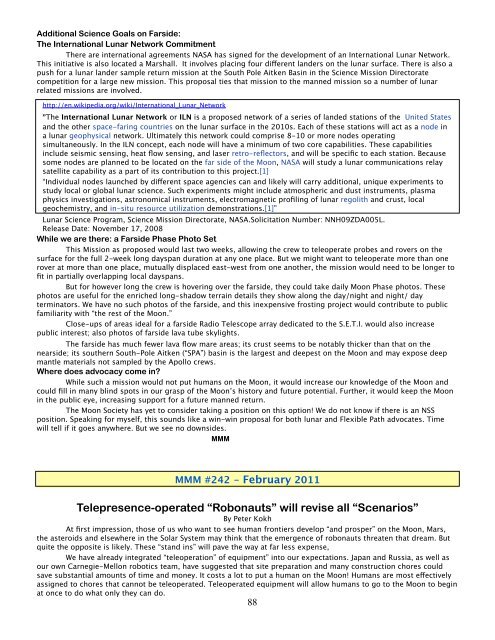Space Transportation - mmmt_transportation.pdf - Moon Society
Space Transportation - mmmt_transportation.pdf - Moon Society
Space Transportation - mmmt_transportation.pdf - Moon Society
You also want an ePaper? Increase the reach of your titles
YUMPU automatically turns print PDFs into web optimized ePapers that Google loves.
Additional Science Goals on Farside:<br />
The International Lunar Network Commitment<br />
There are international agreements NASA has signed for the development of an International Lunar Network.<br />
This initiative is also located a Marshall. It involves placing four different landers on the lunar surface. There is also a<br />
push for a lunar lander sample return mission at the South Pole Aitken Basin in the Science Mission Directorate<br />
competition for a large new mission. This proposal ties that mission to the manned mission so a number of lunar<br />
related missions are involved.<br />
http://en.wikipedia.org/wiki/International_Lunar_Network<br />
”The International Lunar Network or ILN is a proposed network of a series of landed stations of the United States<br />
and the other space-faring countries on the lunar surface in the 2010s. Each of these stations will act as a node in<br />
a lunar geophysical network. Ultimately this network could comprise 8-10 or more nodes operating<br />
simultaneously. In the ILN concept, each node will have a minimum of two core capabilities. These capabilities<br />
include seismic sensing, heat flow sensing, and laser retro-reflectors, and will be specific to each station. Because<br />
some nodes are planned to be located on the far side of the <strong>Moon</strong>, NASA will study a lunar communications relay<br />
satellite capability as a part of its contribution to this project.[1]<br />
“Individual nodes launched by different space agencies can and likely will carry additional, unique experiments to<br />
study local or global lunar science. Such experiments might include atmospheric and dust instruments, plasma<br />
physics investigations, astronomical instruments, electromagnetic profiling of lunar regolith and crust, local<br />
geochemistry, and in-situ resource utilization demonstrations.[1]”<br />
Lunar Science Program, Science Mission Directorate, NASA.Solicitation Number: NNH09ZDA005L.<br />
Release Date: November 17, 2008<br />
While we are there: a Farside Phase Photo Set<br />
This Mission as proposed would last two weeks, allowing the crew to teleoperate probes and rovers on the<br />
surface for the full 2-week long dayspan duration at any one place. But we might want to teleoperate more than one<br />
rover at more than one place, mutually displaced east-west from one another, the mission would need to be longer to<br />
fit in partially overlapping local dayspans.<br />
But for however long the crew is hovering over the farside, they could take daily <strong>Moon</strong> Phase photos. These<br />
photos are useful for the enriched long-shadow terrain details they show along the day/night and night/ day<br />
terminators. We have no such photos of the farside, and this inexpensive frosting project would contribute to public<br />
familiarity with “the rest of the <strong>Moon</strong>.”<br />
Close-ups of areas ideal for a farside Radio Telescope array dedicated to the S.E.T.I. would also increase<br />
public interest; also photos of farside lava tube skylights.<br />
The farside has much fewer lava flow mare areas; its crust seems to be notably thicker than that on the<br />
nearside; its southern South-Pole Aitken (“SPA”) basin is the largest and deepest on the <strong>Moon</strong> and may expose deep<br />
mantle materials not sampled by the Apollo crews.<br />
Where does advocacy come in?<br />
While such a mission would not put humans on the <strong>Moon</strong>, it would increase our knowledge of the <strong>Moon</strong> and<br />
could fill in many blind spots in our grasp of the <strong>Moon</strong>’s history and future potential. Further, it would keep the <strong>Moon</strong><br />
in the public eye, increasing support for a future manned return.<br />
The <strong>Moon</strong> <strong>Society</strong> has yet to consider taking a position on this option! We do not know if there is an NSS<br />
position. Speaking for myself, this sounds like a win-win proposal for both lunar and Flexible Path advocates. Time<br />
will tell if it goes anywhere. But we see no downsides.<br />
MMM<br />
MMM #242 - February 2011<br />
Telepresence-operated “Robonauts” will revise all “Scenarios”<br />
By Peter Kokh<br />
At first impression, those of us who want to see human frontiers develop “and prosper” on the <strong>Moon</strong>, Mars,<br />
the asteroids and elsewhere in the Solar System may think that the emergence of robonauts threaten that dream. But<br />
quite the opposite is likely. These “stand ins” will pave the way at far less expense,<br />
We have already integrated “teleoperation” of equipment” into our expectations. Japan and Russia, as well as<br />
our own Carnegie-Mellon robotics team, have suggested that site preparation and many construction chores could<br />
save substantial amounts of time and money. It costs a lot to put a human on the <strong>Moon</strong>! Humans are most effectively<br />
assigned to chores that cannot be teleoperated. Teleoperated equipment will allow humans to go to the <strong>Moon</strong> to begin<br />
at once to do what only they can do.<br />
88















